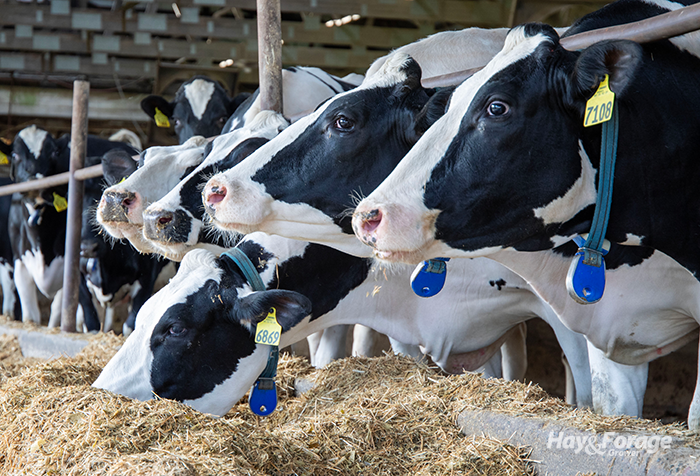Cows can still thrive without BMR corn |
| By Amber Friedrichsen, Managing Editor |
|
|
 Despite the advantages brown midrib (BMR) corn silage brings to the feedbunk, many farmers have shifted their preference back to conventional hybrids in recent years. The changing market dynamics may be attributed to a number of factors, but the consolidation of the dairy industry has largely driven demand for more harvest flexibility and higher tonnage than what many BMR hybrids can offer. For these reasons, Corteva and its associated brands (Pioneer, Brevant, and Dairyland Seeds) have announced they would begin phasing out their BMR corn programs, discontinuing all product offerings by 2030. To address how this might affect dairy ration formulation, the Iowa State University Extension and Outreach Dairy Team hosted a webinar to suggest ways to maintain feed quality without BMR corn as a tool in the toolbox. Pros and cons Considering the lower lignin content and higher fiber digestibility of BMR corn silage, it has potential to enhance dairy cow feed intake, and thus, milk production. According to Adam Krull, these are the primary benefits of growing BMR corn. However, the dairy veterinarian and nutritionist with Pioneer said the drawbacks include a higher risk of lodging, greater incidence of foliar disease, and lower yields. Krull assured the audience that milk production doesn’t have to take a significant hit if BMR corn silage is removed from the equation. Of the three factors that determine corn silage quality — management, genetics, and environment — the environment has three times the influence on the end product than genetics. For example, Krull referenced a study in which conventional hybrids grown under optimal conditions were actually higher in neutral detergent fiber digestibility (NDFD) than BMR hybrids grown under wet conditions. He explained that environmental conditions during vegetative growth stages drive fiber digestibility in corn, whereas conditions during reproductive growth stages drive starch fill. A dry start to the growing season usually creates a shorter plant with lower lignin concentrations, resulting in silage that is lower in fiber and higher in NDFD. On the contrary, wet conditions encourage more growth, which signals plants to lay down more lignin for support, raising fiber levels and reducing NDFD. In fact, Krull noted that irrigated corn almost always has lower NDFD than dryland corn since a consistent supply of water is available to fuel plant growth throughout the season. “The perfect corn silage scenario would be a drier early season, and then the rain would come on post-tassel to get good starch levels, and then the rain would turn off at harvest so we can get in the field on time,” he said. Since early season weather patterns are largely out of a farmer’s control, Krull encouraged the audience to focus on what is. From a management standpoint, this includes using appropriate tillage, setting the planter up correctly, and adjusting soil fertility to optimal levels. Harvest timing and proper storage are key to preserving silage quality, too. From a genetics standpoint, Krull encouraged farmers to select corn hybrids for basic agronomic traits like disease resistance and standability — followed by yield potential and starch content — instead of focusing on the projected fiber digestibility of individual hybrids. Overall, he suggested a good silage hybrid in the field must start out as a good grain hybrid on paper. Cut height could help In addition to planting management and hybrid selection, there are harvest techniques that could help boost silage fiber digestibility. Luiz Ferraretto with the University of Wisconsin-Madison explained how raising the chop height for conventional silage can improve its fiber digestibility to levels similar to BMR corn. Ferraretto, a ruminant nutrition extension specialist, noted BMR fiber digestibility can be as much as seven percentage units higher than that of conventional corn. Research has shown that this bump translates to 5% to 20% less time spent at the feedbunk — and that much more resting time — because cows are not busy sorting. “We know there is a very nice correlation between resting time and milk production,” Ferraretto said. There is also a strong correlation between resting time and butterfat concentrations, he added. Ferraretto stated that corn silage chop height is generally around 8 inches, high-chop corn silage is harvested between 16 to 24 inches, and stalklage is harvested at about 45 inches. Although yield declines with every inch the chopper head is raised, quality should improve since more stalk material, and thus more lignin, is left in the field. “You are basically exchanging yield for quality,” Ferraretto said. A comparison of several studies shows conventional corn chopped at 7 inches had an average of 40% neutral detergent fiber (NDF), 52% starch, and yielded 7.7 tons of dry matter per acre. On the other hand, high-chop corn silage harvested at 21 inches had an average of 37% NDF, 35% starch, and yielded 6.8 tons of dry matter per acre. When both silages were fed to different groups of lactating dairy cows, milk per ton values equaled 3,291 pounds and 3,422 pounds, respectively. Considering the results of the study, Ferraretto advocated for high-chop silage as a way to manipulate NDF levels. He reiterated that high-chopping would negatively impact total forage yield. However, this raised a question from the audience: If farmers are willing to give up yield with BMR hybrids, why not give up the same yield chopping conventional corn silage higher? With that said, if corn experienced a dry start to the growing season, high chopping might not make a significant impact on NDFD considering that stalks may be shorter and contain less lignin. For the same reasons Krull mentioned, Ferraretto said high chopping may be more effective in wet years or on irrigated acres when plants are taller and there is more opportunity to dilute indigestible fiber. |
